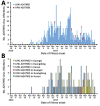Preliminary Epidemiology of Human Infections with Highly Pathogenic Avian Influenza A(H7N9) Virus, China, 2017
- PMID: 28580900
- PMCID: PMC5547798
- DOI: 10.3201/eid2308.170640
Preliminary Epidemiology of Human Infections with Highly Pathogenic Avian Influenza A(H7N9) Virus, China, 2017
Abstract
We compared the characteristics of cases of highly pathogenic avian influenza (HPAI) and low pathogenic avian influenza (LPAI) A(H7N9) virus infections in China. HPAI A(H7N9) case-patients were more likely to have had exposure to sick and dead poultry in rural areas and were hospitalized earlier than were LPAI A(H7N9) case-patients.
Keywords: China; H7N9; HPAI; LPAI; epidemiologic characteristics; epidemiology; highly pathogenic avian influenza; infectious diseases; influenza; respiratory infections; viruses; zoonoses.
Figures


Similar articles
-
Genesis and Spread of Newly Emerged Highly Pathogenic H7N9 Avian Viruses in Mainland China.J Virol. 2017 Nov 14;91(23):e01277-17. doi: 10.1128/JVI.01277-17. Print 2017 Dec 1. J Virol. 2017. PMID: 28956760 Free PMC article.
-
Characterization of H7N9 avian influenza viruses isolated from duck meat products.Transbound Emerg Dis. 2020 Mar;67(2):792-798. doi: 10.1111/tbed.13398. Epub 2019 Nov 6. Transbound Emerg Dis. 2020. PMID: 31650680
-
Did the Highly Pathogenic Avian Influenza A(H7N9) Viruses Emerged in China Raise Increased Threat to Public Health?Vector Borne Zoonotic Dis. 2019 Jan;19(1):22-25. doi: 10.1089/vbz.2018.2299. Epub 2018 Sep 15. Vector Borne Zoonotic Dis. 2019. PMID: 30222520 Review.
-
Epidemiology of human infections with highly pathogenic avian influenza A(H7N9) virus in Guangdong, 2016 to 2017.Euro Surveill. 2017 Jul 6;22(27):30568. doi: 10.2807/1560-7917.ES.2017.22.27.30568. Euro Surveill. 2017. PMID: 28703705 Free PMC article.
-
Viral lung infections: epidemiology, virology, clinical features, and management of avian influenza A(H7N9).Curr Opin Pulm Med. 2014 May;20(3):225-32. doi: 10.1097/MCP.0000000000000047. Curr Opin Pulm Med. 2014. PMID: 24637225 Review.
Cited by
-
Sudden emergence of human infections with H7N9 avian influenza A virus in Hubei province, central China.Sci Rep. 2018 Feb 6;8(1):2486. doi: 10.1038/s41598-018-20988-9. Sci Rep. 2018. PMID: 29410505 Free PMC article.
-
Changing Geographic Patterns and Risk Factors for Avian Influenza A(H7N9) Infections in Humans, China.Emerg Infect Dis. 2018 Jan;24(1):87-94. doi: 10.3201/eid2401.171393. Emerg Infect Dis. 2018. PMID: 29260681 Free PMC article.
-
Avian influenza A (H7N9) virus: from low pathogenic to highly pathogenic.Front Med. 2021 Aug;15(4):507-527. doi: 10.1007/s11684-020-0814-5. Epub 2021 Apr 16. Front Med. 2021. PMID: 33860875 Free PMC article. Review.
-
The viral distribution and pathological characteristics of BALB/c mice infected with highly pathogenic Influenza H7N9 virus.Virol J. 2021 Nov 29;18(1):237. doi: 10.1186/s12985-021-01709-7. Virol J. 2021. PMID: 34844617 Free PMC article.
-
Closure of live bird markets leads to the spread of H7N9 influenza in China.PLoS One. 2018 Dec 12;13(12):e0208884. doi: 10.1371/journal.pone.0208884. eCollection 2018. PLoS One. 2018. PMID: 30540847 Free PMC article.
References
-
- World Health Organization. Human infection with avian influenza A(H7N9) virus—China. Disease outbreak news, 27 February 2017. [cited 2017 May 16]. http://www.who.int/csr/don/27-february-2017-ah7n9-china/en
MeSH terms
Substances
LinkOut - more resources
Full Text Sources
Other Literature Sources
Medical

